The Magic of AI in Anime Creation
Welcome to SocialSight's guide to generating stunning anime visuals using AI! Anime art has a unique charm, and with AI, you can bring your own characters, scenes, and stories to life like never before. This guide will teach you how to write effective prompts for SocialSight's Free AI Anime Generator. Our system already knows you want to create anime, so your prompts should focus on describing the *specifics* of your desired image.
Defining Your Anime Scene's Core Vision
Before you start prompting, take a moment to visualize the scene or character. What's the mood? What's happening? Who is the focus? A clear vision helps create more targeted and successful prompts. Is it a dramatic battle, a serene landscape, or a cute character portrait?
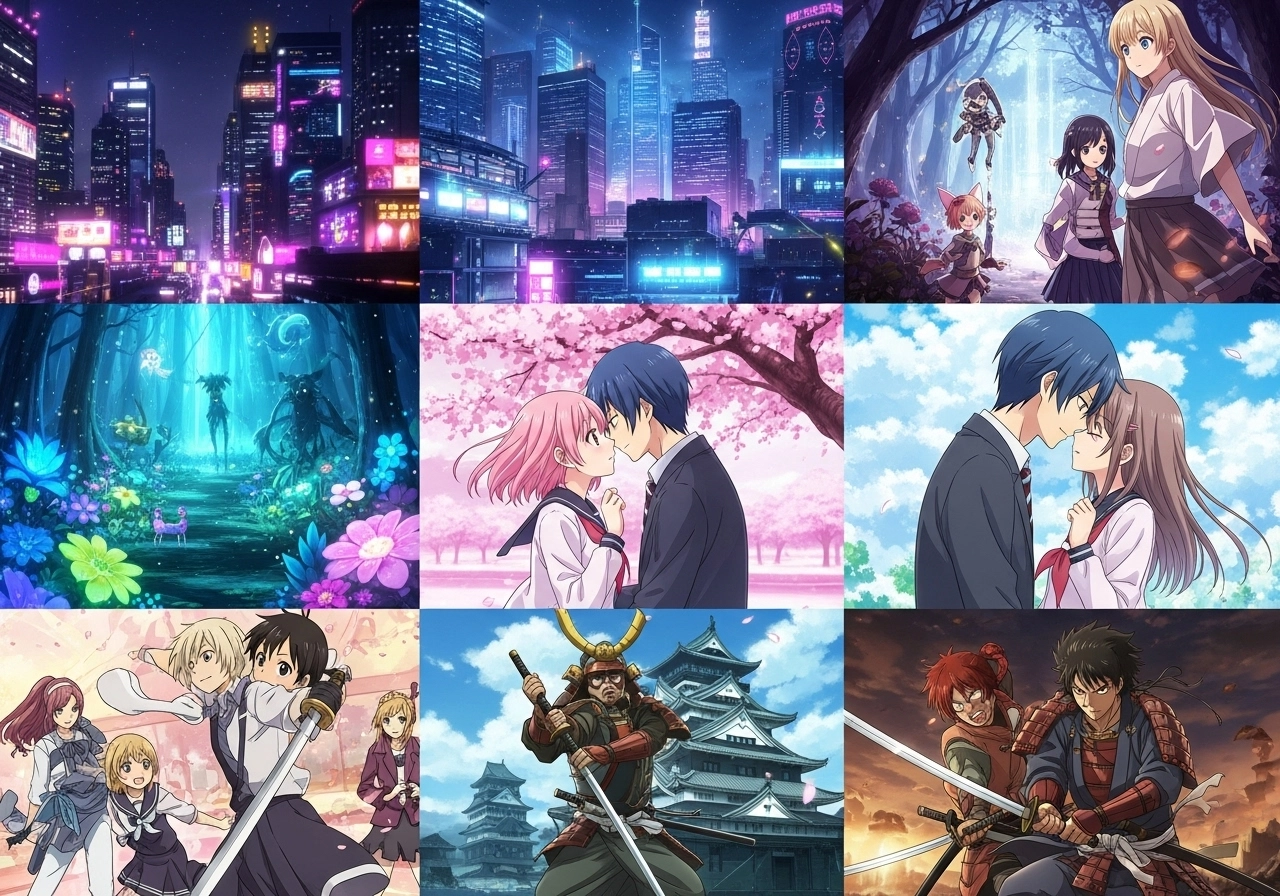
A vibrant collage of anime scenes: a futuristic city, a magical forest, a high school romance, a samurai fight. Various character expressions and styles.Pillar 1: Character Design - Bringing Your Stars to Life
Characters are often the heart of anime. Be as specific or as general as you like with their features.
Defining Character Appearance (Hair, Eyes, Face)
Describe the physical traits of your character(s).
- Hair: long flowing silver hair, spiky bright red hair, short messy black hair with blue highlights, twin tails, braided pigtails.
- Eyes: large innocent blue eyes, sharp piercing golden eyes, heterochromia (one red eye, one blue eye), closed eyes, smiling eyes.
- Face: gentle smile, determined frown, round youthful face, sharp angular features, cat ears and tail, elf ears.
- Age & Gender: young boy, teenage girl, old master, androgynous character.
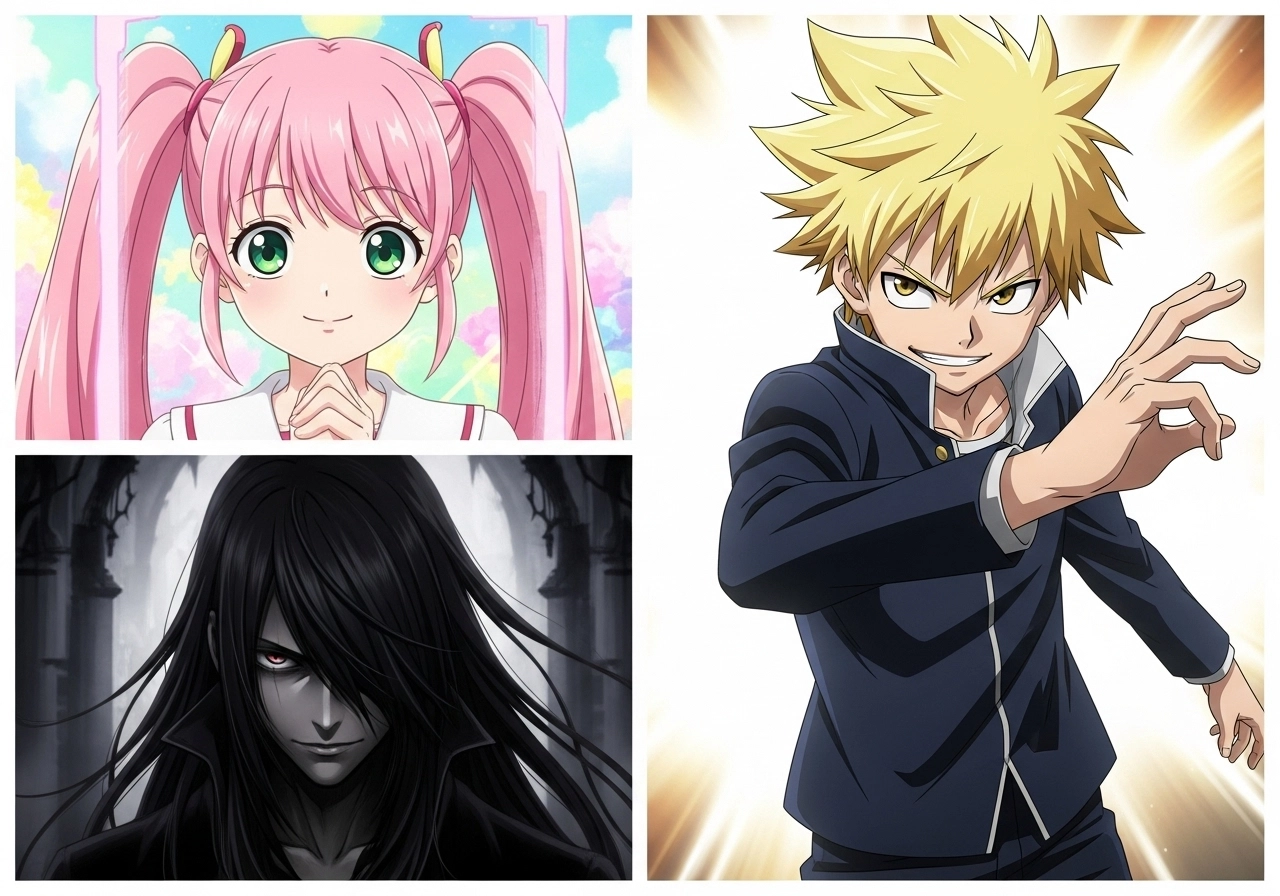
Grid of anime character portraits: Top-left - girl with pink twin tails, big green eyes. Top-right - boy with spiky blond hair, confident smirk. Bottom-left - mysterious figure with long black hair covering one eye.Clothing & Accessories
What are your characters wearing? Details can define their role or personality.
- Outfits: traditional school uniform, futuristic sci-fi armor, elegant fantasy mage robe, casual modern hoodie and jeans, kimono, battle-damaged clothing.
- Accessories: wearing glasses, a red scarf, holding a magical staff, cat-eye goggles, knight's sword, steampunk gears.
Pose & Expression
Convey emotion and action through poses and facial expressions.
- Poses: standing confidently, dynamic action pose, sitting pensively by a window, mid-air jump, back view looking at a landscape, fighting stance.
- Expressions: joyful laughter, intense concentration, shy blush, angry shout, sad tears, smirking.

Anime warrior girl, mid-attack, wielding a glowing sword, determined expression, dynamic pose, motion lines.Multiple Characters & Interactions
If you have more than one character, describe their relationship or interaction.
- two friends talking on a bench
- a hero confronting a villain
- a couple holding hands
- group of adventurers, 3 boys 2 girls, looking at a map (Number of characters can be tricky, be prepared for variations).
Pillar 2: Art Style & Aesthetics - Setting the Visual Tone
The art style defines the overall look and feel of your anime image. Be specific if you have a particular aesthetic in mind.
Common Anime & Manga Styles to Explore
- Shonen: classic shonen style, action-packed, dynamic lines (e.g., Dragon Ball, Naruto, One Piece inspired).
- Shojo: elegant shojo style, large expressive eyes, romantic feel (e.g., Sailor Moon, Fruits Basket inspired).
- Seinen: mature seinen style, more realistic proportions, darker themes (e.g., Berserk, Ghost in the Shell inspired).
- Chibi: cute chibi style, small bodies, large heads, adorable.
- Mecha: detailed mecha anime style, giant robots, technological details.
- Slice of Life: warm slice of life anime style, soft colors, everyday scenes.
- Ghibli-esque: Studio Ghibli inspired style, whimsical, painterly backgrounds, nostalgic feel.
- Retro Anime: 80s anime style, 90s anime aesthetic, cel shaded look, film grain.
- Modern Anime: crisp modern anime style, vibrant colors, detailed lighting and shadows.
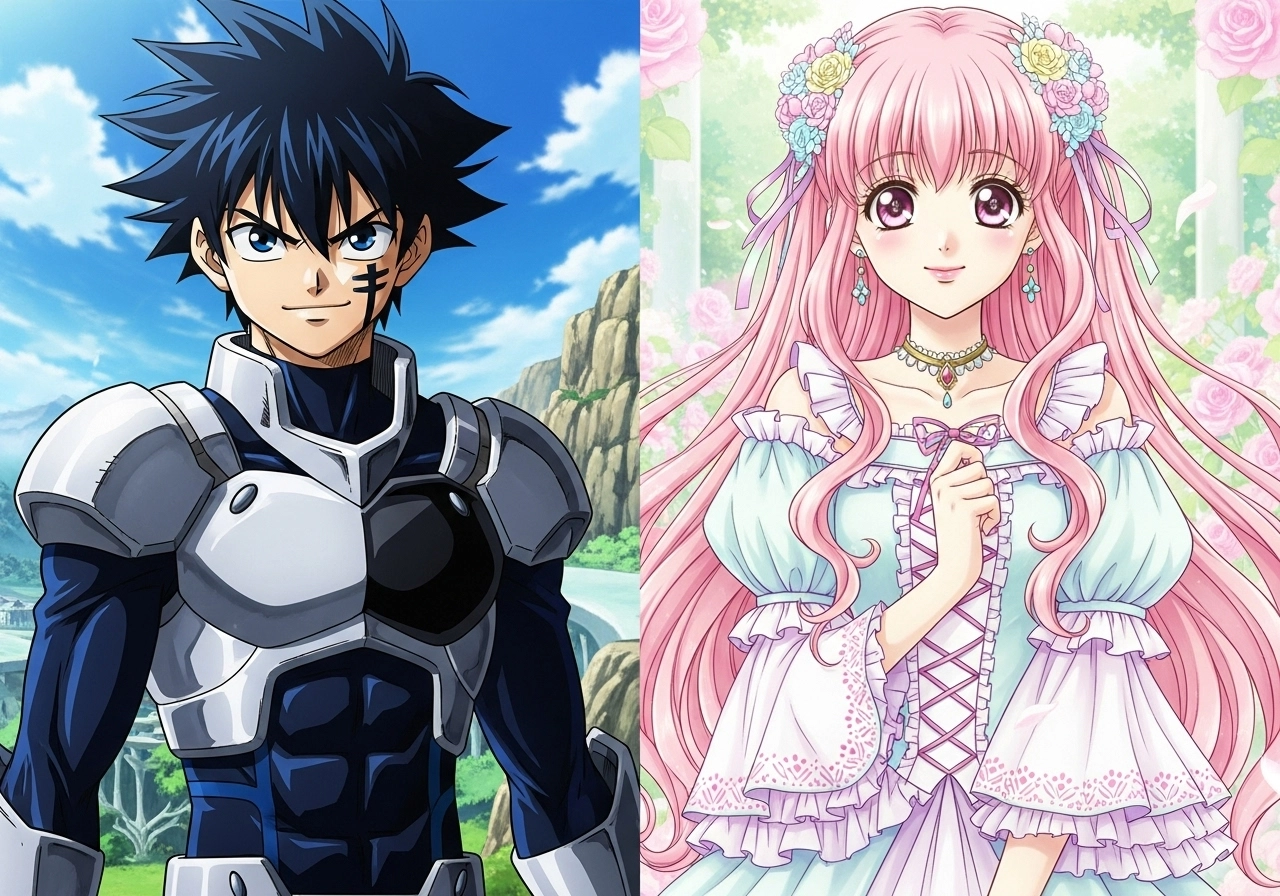
Side-by-side anime character portraits. Left: Shonen style hero, spiky hair, determined look. Right: Shojo style heroine, large sparkling eyes, soft features.Referencing Specific Anime Series or Artist Styles
You can try to evoke the style of a particular artist or series (results may vary based on AI model knowledge).
- in the style of Makoto Shinkai (known for beautiful skies and lighting).
- art style similar to Attack on Titan (gritty, detailed).
- CLAMP inspired artwork (elegant, detailed, elongated figures).
Era & Genre-Specific Styles
Styles can also be tied to historical periods or specific genres.
- vintage sci-fi anime aesthetic
- dark fantasy anime art
- cyberpunk anime illustration
- traditional Japanese painting influence
Pillar 3: Setting & Background - Crafting the World
The environment your characters inhabit is crucial for storytelling and mood.
Describing the Environment
- Location Type: bustling futuristic cityscape, serene bamboo forest, cozy cluttered magic shop interior, high school classroom, epic mountain range, post-apocalyptic ruins, on a spaceship bridge.
- Specific Elements: cherry blossom trees in bloom, neon signs reflecting on wet streets, ancient glowing runes on stone walls, view of Earth from a spaceship window.
Time of Day & Atmosphere
- Time: golden hour sunset, starry night sky, bright sunny afternoon, misty dawn, ominous twilight.
- Atmosphere: dreamy and ethereal, dark and foreboding, peaceful and tranquil, chaotic and energetic, mysterious and magical.
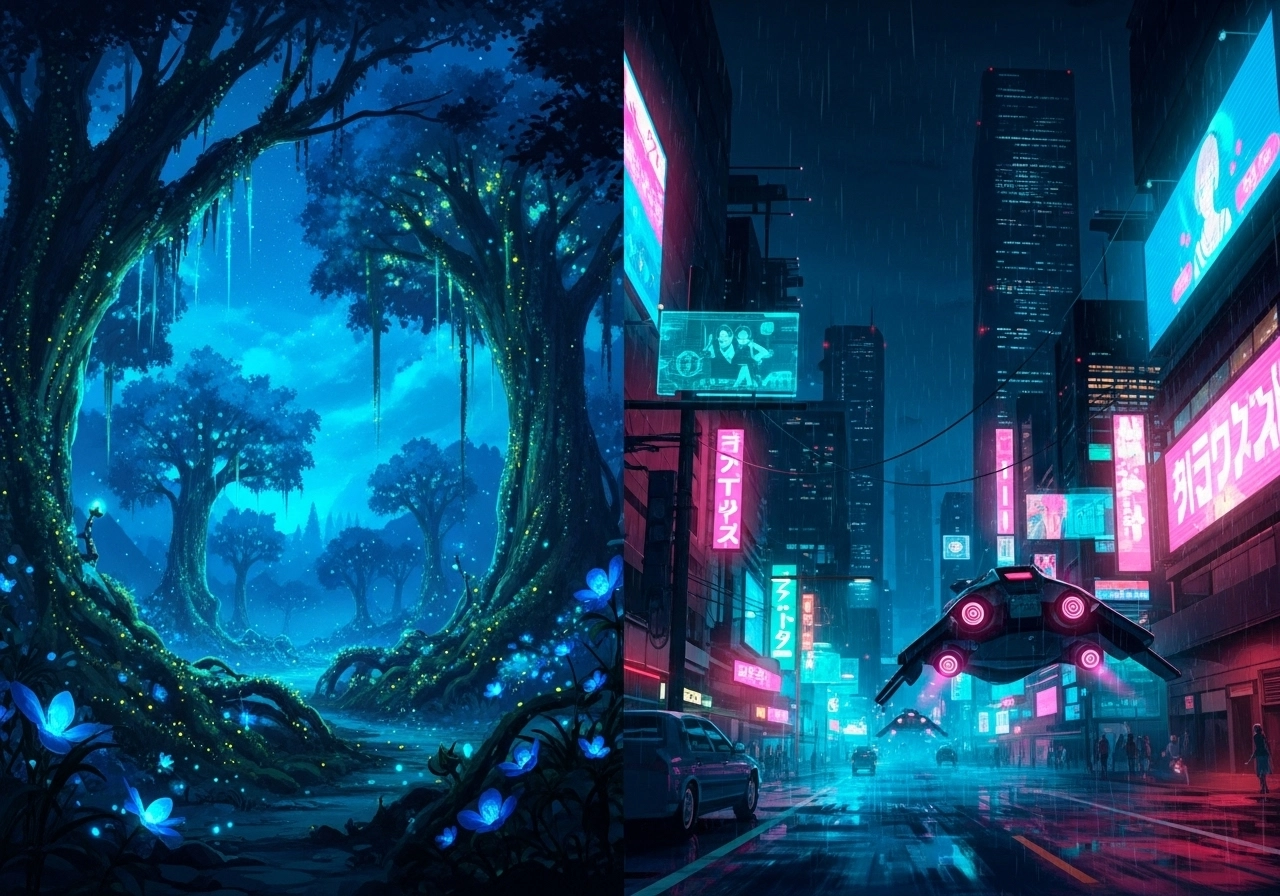
Dual anime landscapes. Left: mystical forest at twilight, glowing plants, ancient trees. Right: cyberpunk city at night, neon lights, flying vehicles.Background Detail Level
- highly detailed background
- simple blurred background
- impressionistic background
- bokeh effect in background
Pillar 4: Scene Composition & Framing - Directing the Shot
How the scene is composed and framed significantly impacts the viewer's focus and the story being told.
Shot Types & Framing
- Close-up: extreme close-up on eyes, character portrait (shoulders up).
- Medium Shot: waist-up shot, cowboy shot (mid-thigh up).
- Full Body Shot: full body character shot.
- Wide Shot/Landscape: expansive landscape view, establishing shot of a city.
- Over-the-Shoulder Shot: over-the-shoulder view of character looking at something.
Camera Angles & Perspective
- Eye-Level View: straight-on eye-level shot.
- Low Angle Shot: worm's eye view, looking up (makes subject look powerful).
- High Angle Shot: bird's eye view, looking down (can make subject look vulnerable or show an overview).
- Dutch Angle / Tilted Camera: dutch angle for dramatic effect (creates unease or dynamism).
- Profile View: side profile of character.
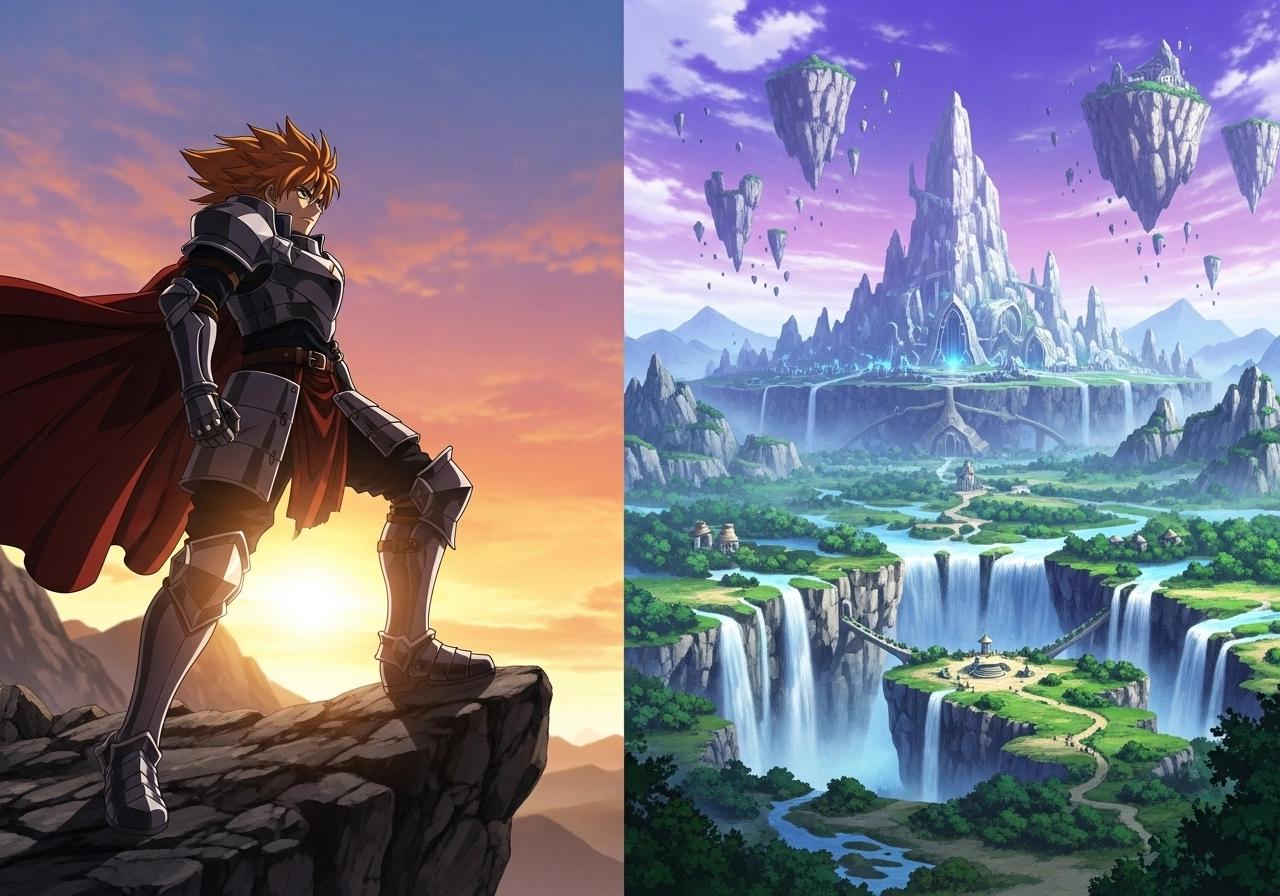
Anime scene composition examples. Left: low angle shot of a hero looking imposing. Right: wide shot of a breathtaking fantasy landscape.Dynamic Action vs. Static Scenes
Specify if the scene should be full of movement or calm and still.
- dynamic action scene, sense of speed and motion.
- calm and static scene, peaceful moment.
- dramatic confrontation.
Pillar 5: Color Palette & Lighting - Evoking Emotion
Color and light are key to setting the mood and drawing attention to focal points.
Specifying Color Schemes & Vibrancy
- Vibrancy: vibrant and saturated colors, muted and desaturated color palette, pastel colors.
- Specific Colors: predominantly blue and white, warm autumn colors (red, orange, brown), monochromatic black and white with red accents.
- Temperature: warm lighting, cool blue tones.
Lighting Effects & Mood
- Types of Light: soft diffused lighting, hard dramatic shadows, god rays streaming through clouds, backlighting creating a silhouette, glowing magical aura, neon glow.
- Mood: cinematic lighting, atmospheric lighting, mysterious dim lighting, bright and cheerful lighting.
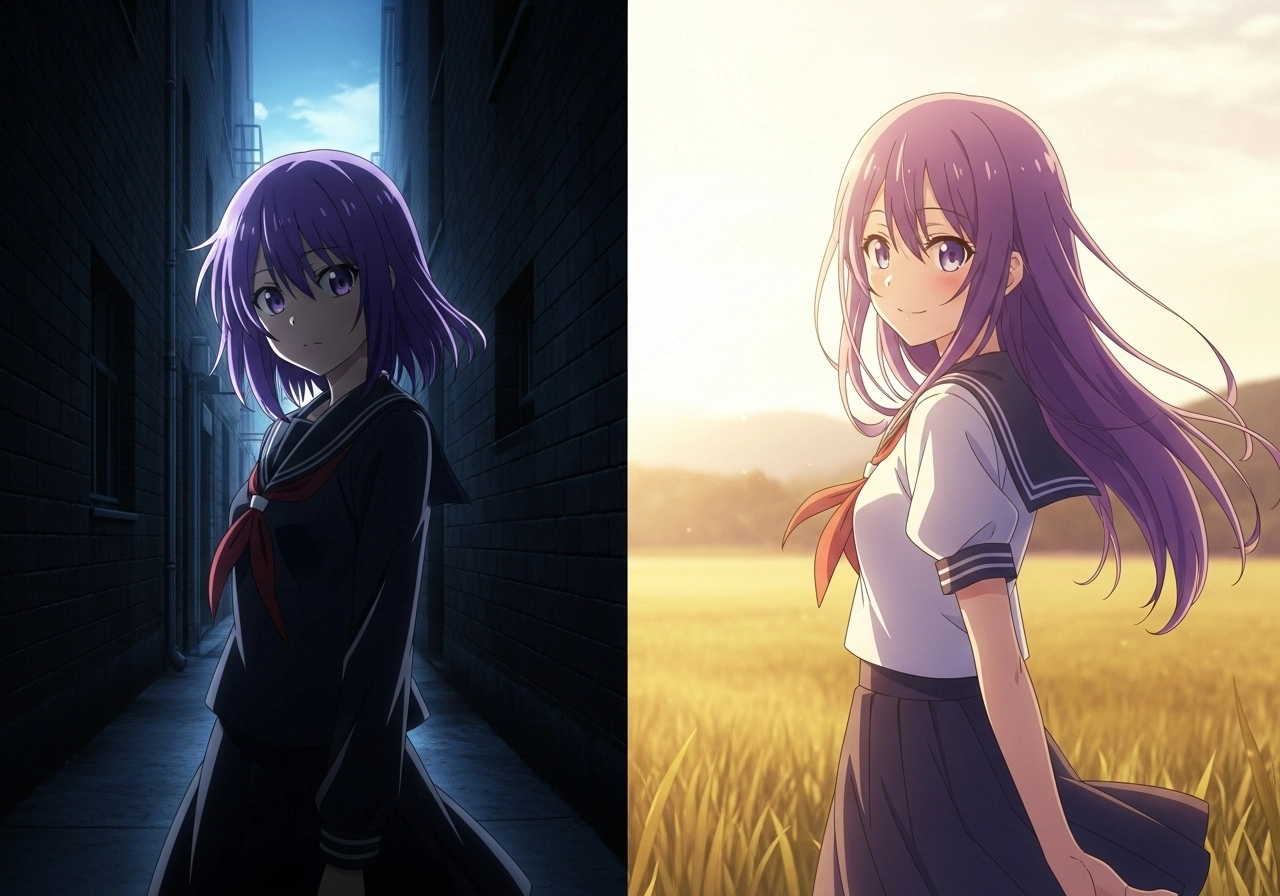
Anime scene lighting comparison. Left: character in a dark alley with dramatic rim lighting. Right: character in a field with soft, golden hour sunlight, dreamy atmosphere.Pillar 6: Details & Special Effects - Adding Flair
Small details and special effects can elevate your anime image from good to great.
Action Lines & Motion Blur
- speed lines for emphasis
- subtle motion blur on moving elements
- impact effect, debris flying
Magical Auras & Elemental Effects
- character surrounded by a glowing blue energy aura
- fireball in hand
- ice shards forming
- sparkling magic particles
- wind effect, hair and clothes blowing.
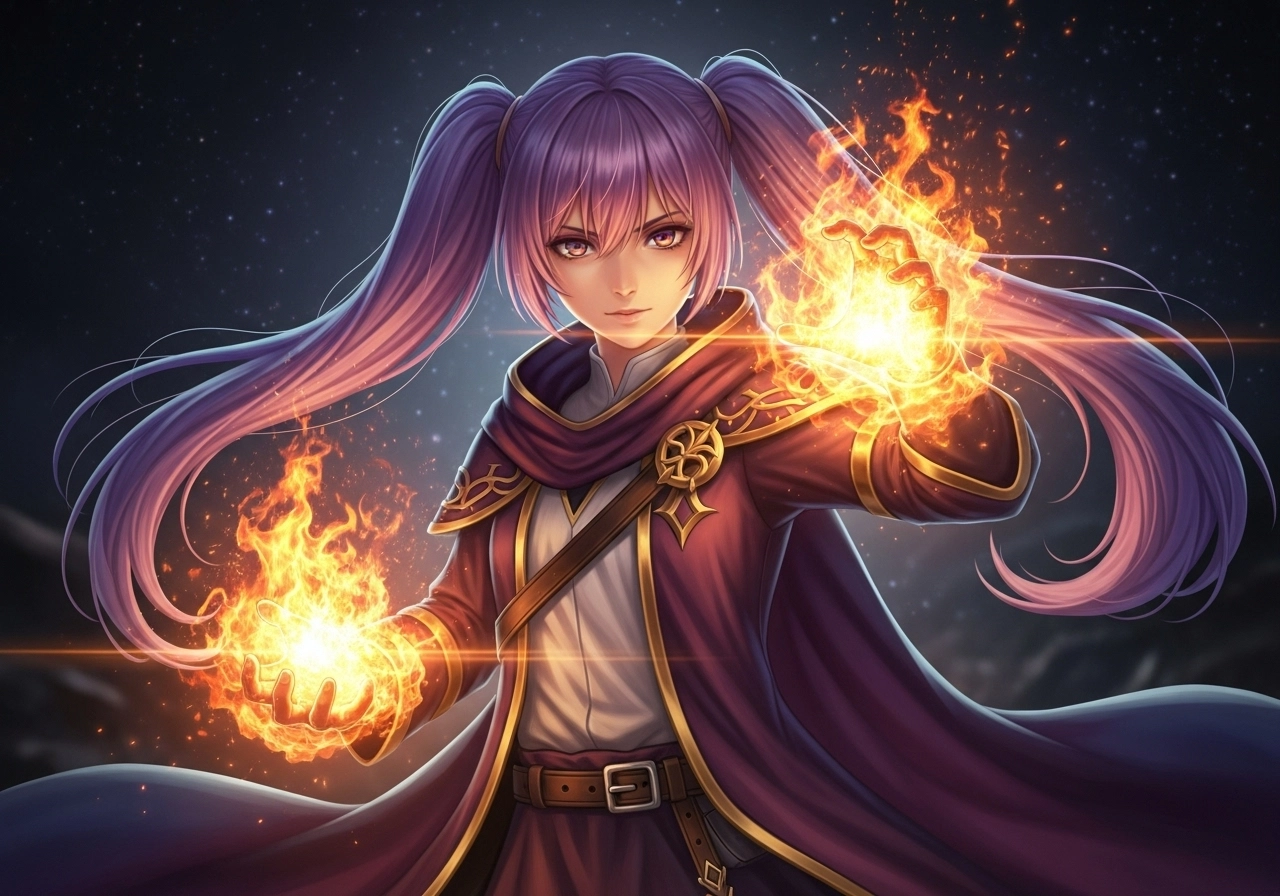
Anime mage casting a spell, hands engulfed in realistic fire, glowing embers, intense magical aura surrounding them.Advanced Anime Prompting Techniques
Combining Complex Elements Effectively
When combining many elements, be clear and concise. Use commas to separate distinct concepts. Prioritize what's most important. For example: 1girl, silver hair, blue eyes, wearing a black leather jacket, riding a motorcycle, futuristic city street at night, neon lights, rain, cinematic lighting, 90s anime style.
Specifying "Landscape Only" or "Character Focus"
If you want to ensure the focus is on the environment or specifically exclude characters (or vice versa):
- anime landscape, no characters, mystical forest, volumetric lighting
- character concept, white background, full body shot, detailed clothing (to focus on character design without a complex scene).
- scenery, beautiful anime sky, clouds, sunset
Common Pitfalls & Troubleshooting
- Too Many Details: Overloading the prompt can confuse the AI. Start simpler and add complexity.
- Conflicting Styles: Requesting chibi style and hyperrealistic detail might produce odd results.
- Hands & Complex Poses: AI can sometimes struggle with hands or very specific complex poses. Re-roll or simplify if needed.
- Text Generation: AI image generators are generally not good at rendering legible text within images. Avoid prompting for specific text.
- Character Consistency: Generating the exact same character across multiple images is very challenging. Focus on key features to maintain similarity.
Ready to Create Your Own Anime Masterpiece?
Experiment with these anime prompting techniques and bring your imagination to life with SocialSight's AI tools.
Try SocialSight's Free AI Anime Generator!Need more help? Check out our main prompting guide.